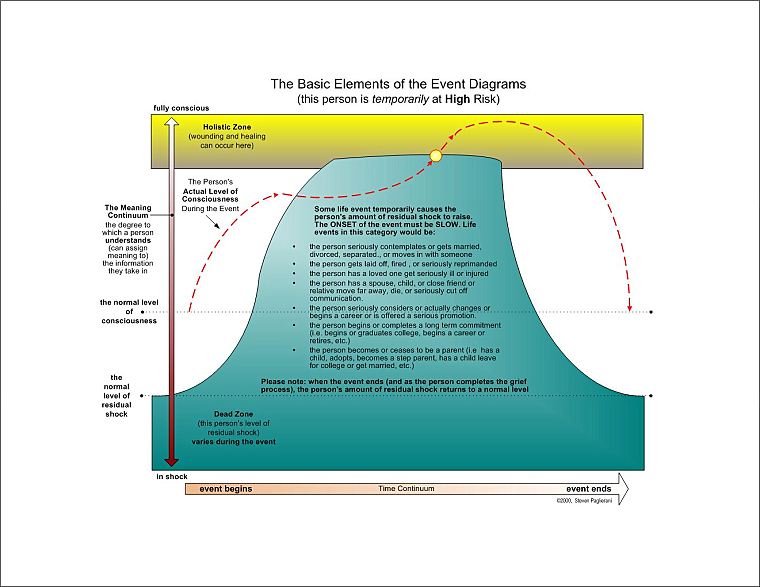
The Chart of a Person Who is at Low Risk
In this section, I describe in more detail the basic elements which make up each event diagram.
To begin with, all event diagrams use the same five element format; [1] a "time" line, [2] a "meaning" line, [3] a "normal level of consciousness" line, [4] an "actual level of consciousness" line, and [5] a rectangular area which represents a person's "residual level of shock," the amount of internal background noise we each live with every day.
Now, if you look at the lower portion of the diagram above, you will see the first of these five elements, a horizontal line labeled, the [1] "time" continuum.
This line, which runs from lower left to lower right, is simply a line which represents the passing of time during this particular event. Thus, the left end of this line represents a point in time before the event, and the right end, a point in time after the event. In a sense, this line is simply a clock using a straight line.
Crossing this horizontal line is the second element, a vertical line with an arrow at each end. This line is the person's [2] "meaning" continuum, and it represents how consciously people are processing the information they are sensing at any given time during the event; in other words, the degree to which they are able to assign a meaning to the event as it occurs. This is directly related to peoples' ability to picture the event and so, this line can also be seen to represent the degree to which a person can picture the event.
Now. using this idea, the ability to picture, at the upper end of the line, which is labeled "fully conscious," the person completely pictures, and therefore can assign meanings to what is being seen or heard or sensed, while at the lower end of the line, which is labeled "in shock, the person pictures none of what is being seen or felt or sensed and so, assigns no meaning to what is happening.
As for the extremes, at the upper end of this line, the person is experiencing "a moment of clarity," an "aha" experience, or an "emergence," and at the lower end of this line, the person is "in a fog," "zoned out," or is completely detached from the life event.
The third element of these diagrams is the [3] person's "normal level of consciousness" line. This line crosses the meaning line at a level of consciousness which is a normal average for most people. Of course, this line represents only an average, and each person's level of consciousness actually varies from moment to moment.
The fourth element is the [4] person's "actual level of consciousness line." This line represents the person's actual level of consciousness at any given moment during the event. Thus, like the time line, it proceeds in time from left to right.
The final element in the life event diagrams is represented by a filled in rectangle which begins in the lower left hand corner of the diagram. This rectangle represents the [5] person's "residual level of shock," in a sense, the person's internal level of background noise. Now, if you have ever noticed how the sound of the air moving around a fast moving car can obscure the music playing on the car's radio, you have a good idea of what this residual shock is like.

A Person Who is Temporarily at High Risk
Actually, the fast moving car metaphor is one of the easiest ways to understand what these diagrams represent. Thus, if you can imagine that you are riding in a car with the radio on and the windows open, the first diagram below would represent the car at a stop sign, wherein the "actual level of consciousness" line represents the volume of the car radio, and the level of residual shock represents the level of background noise outside the car.
In this first diagram, you would be able to hear all of the music, as the volume of the music would remain louder than the volume of the background noise. But what would happen to the music when the car started to move?
Obviously, the faster you drove the car, the higher the level of background noise would be. This condition is what the second diagram, the one right below, represents, wherein you are driving your car rather fast and so, the wind noise around the car is rather high.
